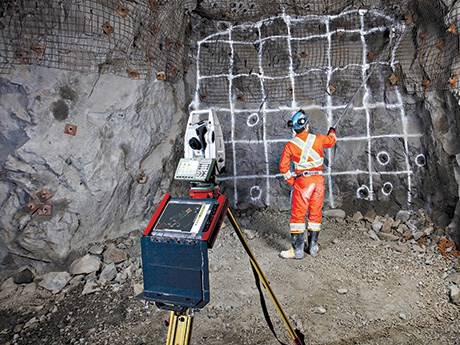Northern Survey Supply sells MOSS to Goldcorp’s Hoyle Pond Mine
Northern Survey Supply (NSS), a surveying equipment distributor serving the mining industry from offices in Sudbury and Mattawa, has announced the sale of a Miner Operated Survey System (MOSS) to Goldcorp’s Hoyle Pond Mine in Timmins.
MOSS, developed years ago by former Falconbridge employee Bernie Smith and still in use by Glencore at its Nickel Rim and Raglan mines in Ontario and Quebec, was updated last year and made available to the global mining industry by NSS.
Operated by a single miner, the robotic system allows every round to be surveyed and evaluated for overbreak and underbreak, performs daily volume calculations that are 80 per cent more precise, marks up every round, scans and photographs the face for geological mapping and documents ground support.
MOSS was trialed at Hoyle Pond for two months and was enthusiastically accepted by the crews using it.
NSS senior account manager Bruno Lalonde had high praise for the way Hoyle Pond management introduced the new technology.
“We expected some pushback, but it went very smoothly because of the way it was rolled out. Two months before we showed up for the trial, Paul Levesques and Jim Parisé told the jumbo operators that MOSS was coming. They told them to Google MOSS, check out our website and be prepared to ask questions when we came in. There was full buy-in from both management and miners.”
Several other Goldcorp operations are also showing interest in MOSS, including the company’s Eleonore operation in Quebec, which has committed to a trial.
NSS is also trialing MOSS at Tahoe Resources’ Bell Creek Mine and hit paydirt at the PDAC in March when Jaguar Mining in Brazil agreed to a trial and a sale was made to Lion One Metals, a British Columbia-based miner that owns the Tuvatu gold mine in Fiji.
“It took awhile, but we’re really starting to see some traction,” said Lalonde. “We recently brought on two engineers in training, one contractor and we’re looking for more. We’re in a hiring frenzy.”
Historically, the mining industry has been slow to adopt new technology, but that’s changing, said Lalonde. “They see the need for new technology to get the job done more efficiently and accurately.”
Overbreak in the industry runs as high as 30 per cent, but MOSS brings that down to less than 10 percent, resulting in less waste and a quick return on investment.
“The ROI is within 90 to 100 metres of development,” said Lalonde. “The cost savings are huge.”
Based on 2,000 metres of annual development in five-metre by five-metre drifts, NSS estimates savings of more than $2 million.
A tablet is used to overlay the surveys on the mine plan allowing operators to see what they need to do for every round and what corrective actions they need to make. It then tells the miner exactly where to collar the holes for the next round within millimetres of accuracy.
The entire procedure takes 15 minutes compared to the hour it usually takes using traditional methods.
MOSS works with the Leica MS60 multistation to perform a full 3D LiDAR scan, creating a point cloud and a 3D mesh allowing for the precise calculation of volume.
The 3D mapping can be used by geologists to view structures and map the face.
“If the miner has any concerns and WiFi is available, he can connect to the network and share the imagery with the geologist on surface,” said Lalonde. “Geologists can see what the face looks like, map out the direction of the vein and provide instructions to the miner from his desk on surface.”
Typically, they would have to come down to the face to evaluate the geology and provide direction, which takes time, isn’t always practical and usually doesn’t happen, often resulting in deviation and increased waste.
MOSS interfaces with all mine design software products and can also be used to do cavity monitoring, eliminating the need for a dedicated cavity monitoring system.



